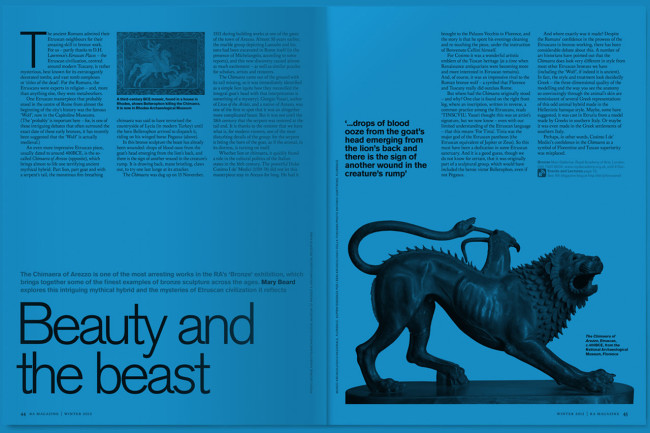Paolozzi’s threatened Tottenham Court Road mosaics
Paolozzi’s threatened Tottenham Court Road mosaics
By Richard Cork
Published 21 May 2015
As parts of Eduardo Paolozzi RA’s mosaics are removed from Tottenham Court Road tube station ahead of Crossrail, Richard Cork hopes that Transport for London will honour its promises.
-
From the Summer 2015 issue of RA Magazine, issued quarterly to Friends of the RA.
The London Tube was greeted with ecstatic enthusiasm by Marinetti, the flamboyant leader of the Italian Futurist movement. In 1912, after his first-ever journey on the Underground, he told a reporter that it had been a revelation, giving him exactly what he wanted, “not enjoyment, but a totally new idea of motion, of speed”. The experience was so enthralling that he announced: “London itself is a Futurist city!”
Since then, plenty of artists have shared Marinetti’s excitement. The first time I met Francis Bacon, in 1971, he took me to lunch in Soho. Rather than hailing a taxi, he insisted we take the Tube and told me: “I love shooting through tunnels in a metal cylinder!” Nine years later, Eduardo Paolozzi RA was delighted when London Transport commissioned him to make extensive mosaic artworks for the platforms and entrance of Tottenham Court Road Station.
The outcome, which took six years to complete, was so exuberant that the Royal Academy invited me to curate a special exhibition in 1986 called “Eduardo Paolozzi Underground.” The show, and its accompanying book, celebrated a richly coloured tour de force, which Roger de Grey, then RA President, hailed as proof that “art can transform our everyday surroundings and need not be restricted to the narrow confines of art galleries.”
He was right. Thousands of passengers had already responded on a daily basis to the mosaics emblazoning walls and ceilings in one of the busiest metropolitan Tube stations. The commuters’ reaction was very important to Paolozzi, who asked himself: “What happens when people pass quickly through the station on the train? Will people relate to the metaphors I sought in connection with life above ground – cameras, music shops, saxophones, electronics? These are all in my designs, in addition to an Egyptian panel, because the British Museum is in the neighbourhood.”
-
London itself is a Futurist city!
F. T. Marinetti
-
Travellers alighting at Tottenham Court Road were confronted by a feast of fiery images, ousting the bleakness of the old platforms. These included robotic faces, as well as a brilliant butterfly which pays tribute to Paolozzi’s memories of an all-night Turkish bath in the nearby Russell Hotel.
Moving up from the platforms, passengers were surrounded by mosaics in the station’s rotunda. Here Paolozzi juxtaposed a frowning primitive mask with a comic-strip man running, which he described as an “Orwellian commuter.” Although partially obstructed by lighting tubes suspended in front of them, these images had a forceful impact and led the eye to the more abstract mosaics on the arches at the top of the main escalator.
Now, as part of a £400 million redevelopment of the station ahead of the Crossrail scheme, Transport for London has dismantled the arches. The loss is very saddening, and I wish it had not happened. Even though the Paolozzi Foundation agreed with the decision to remove them, the arch mosaics are much missed by many who had grown to love them over the past three decades.
-

Eduardo Paolozzi, Designs for the mosaics on the Central Line station platforms at Tottenham Court Road, 1982.
© TRUSTEES OF THE PAOLOZZI FOUNDATION, LICENSED BY DACS 2015.
-
At least Hawkins\Brown, the architects responsible for the station’s redevelopment, have incorporated bold new artworks by Daniel Buren for what they describe as “a modern, day-lit space there five times as large.” Buren is an artist I have admired ever since he created some large, temporary billboard stripes for an outdoor location in Piccadilly in 1972. Since then, he has transformed major public locations across Europe, including the great courtyard of the Palais Royal in Paris. His Tottenham Court Road artworks, revealed this summer, are emphatic abstractions using severely simplified forms and arresting colours. “The final result of what I do is to break boundaries and go further,” Buren told me. “I really like to work with the public situation – museums only attract a portion of the population. The public in the Tube station is absolutely everyone, and there is a constant flux of people running both ways. I want to offer them a beautiful balloon of oxygen for the spirit.”
TfL wants to reassure us about the mosaics, declaring that “95 per cent of the mosaics have been saved in their original locations” across the station as a whole. They are being restored as well, and TfL also claims that a large mosaic panel near the arches at the former Oxford Street entrance has been “removed by restoration experts, and safely preserved for redisplay within the station” once upgrade works are complete in 2016. Those who are dismayed by the loss of the arches will be monitoring this new scheme closely, trying to ensure that TfL honours its promises.
The full scheme of artworks by Daniel Buren are unveiled at Tottenham Court Road on 9 June.
Richard Cork is an art critic, curator and broadcaster. He is author of The Healing Presence of Art (Yale, 2012) and Face to Face: Interviews with Artists (Tate Publishing, 2015).
-
-
Enjoyed this article?
Become a Friend to receive RA Magazine
“As well as free entry to all of our exhibitions, Friends of the RA enjoy one of Britain’s most respected art magazines, delivered directly to your door. Why not join the club? ”

-





